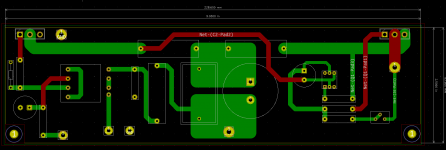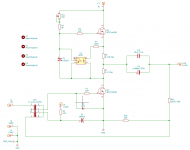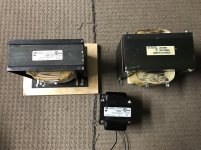oh yeah, sleepy
biasing is OK, issue with too much swing asked from xformer most likely stays
biasing is OK, issue with too much swing asked from xformer most likely stays
I am very intrigued by Papa’s original Schade design. My first thought is I don’t need 50W of power. So, can I reduce the current and also get dissipation down to 90W per channel, thereby fitting it into a single 4U chassis. I searched the thread but didn’t find anyone playing around with different operating points. Has this been explored? Thanks!
It's certainly scalable. I think ZM mentioned somwhere, that a 25Vds and around ~2A is about the minimum for those big IFXN for decent performance, not to say it won't work. The choke load is a great option, as it cuts the dissipation in half, with roughly the same performance, though you may run out of space fitting chokes and a PS in a 4U. You could drop in some IRFP240's in the orig circuit, lower the voltage, increase the power resistor's values to lower the bias, and put a pot in the upper half to fine tune the bias. I remember people talking about doing just that early on in this thread, never saw anything else from it.
I tried to run p240s with ~40v at half the current, but I couldn't get it to work. Probably had nothing to do with output change. I probably p2p wired the opti-coupler or input transformer incorrectly. Didnt blow up.
Just no sound.
Just no sound.
Thanks Mega and Vince! Great ideas. Papa’s idea of using the transformer primary as the Schade feedback connection is just so elegant. I think I will give this a go with irfps and see what I get. Will probably be a while though…. The familiar problem of too many projects and not enough time.
too many projects and not enough time.
I know the feeling all too well!
Well, here's what I came up with....I mean, who doesn't like a mini version right?!? I'm KiCad amateur at best. Of course the width here is primarily a function of it fitting my heatsinks, I guess it could be made to fit the UMS if desired.
-John
Attachments
That is baaaaad Mega! Can’t wait to see the result.
Thanks for drawing up the pcb earlier—I missed that, sorry. Will ping you once I get the bench cleared up for the next project.
Thanks for drawing up the pcb earlier—I missed that, sorry. Will ping you once I get the bench cleared up for the next project.
Note the fine print:
Results given are for black anodised heatsinks based on a temperature rise of 60°c above ambient. Performance figures are for guidance only, as operating conditions vary.
The higher the temperature rise above ambient, the better the C/W. If you are counting on a temperature rise of 25 or 30 degrees C above ambient, the C/W number would be much higher.
Results given are for black anodised heatsinks based on a temperature rise of 60°c above ambient. Performance figures are for guidance only, as operating conditions vary.
The higher the temperature rise above ambient, the better the C/W. If you are counting on a temperature rise of 25 or 30 degrees C above ambient, the C/W number would be much higher.
Since I had these Heatsinks just sitting on a shelf I decide to cross my fingers and wing it. And yes ZM, I had to add fans to survive.Note the fine print:
Results given are for black anodised heatsinks based on a temperature rise of 60°c above ambient. Performance figures are for guidance only, as operating conditions vary.
The higher the temperature rise above ambient, the better the C/W. If you are counting on a temperature rise of 25 or 30 degrees C above ambient, the C/W number would be much higher.
Regards,
Dan
- Home
- Amplifiers
- Pass Labs
- 50w Single-Ended BAF2015 Schade Enabled






